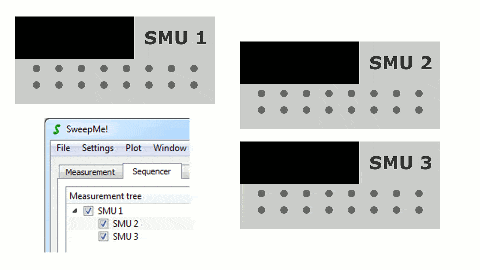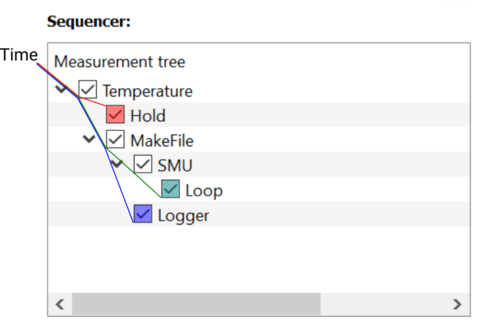Sequencer: Difference between revisions
(→Root) |
(→Child) |
||
| Line 84: | Line 84: | ||
The root module of the sequencer is always an invisible module called "Time". It is part of any measurement and is part of any branch that you add to the sequencer. Thus, you will always have a timestamp in your measurement data. | The root module of the sequencer is always an invisible module called "Time". It is part of any measurement and is part of any branch that you add to the sequencer. Thus, you will always have a timestamp in your measurement data. | ||
=== Child === | === Child module === | ||
A child module is the module that is inserted into a | A child module is the module that is inserted into a another module. We also say it is "nested" into the above module. For example, the module 'MakeFile' is a child of the module 'Temperature' in the example shown in the figure. | ||
=== Parent === | === Parent === | ||
Revision as of 11:57, 11 July 2022
The sequencer is the heart of SweepMe!. Use it to create tree-like measurement sequences. Items can be placed by drag&drop from a list of all available Modules. There exists basic examples (Settings -> Load Example) that demonstrate the creation of measurement procedures.
Procedures
The sequencer presents a measurement in a tree-like hierarchy of modules. Each module can be understood as a for-loop over its sweep values. These sweep values can be seen as set values that have to be applied and reached to perform a measurement point. Whenever modules are nested into each other, it automatically means that nested for-loops are created. As for any tree, there exist branches. If you have a single branch, all items are nested into each other. This is the most simple and basic configuration you can realize. In this case, SweepMe! will perform variation across all combinations of set values of each module in the branch. Each combination can be seen as a measurement point for which all modules of the sequencer are asked for their measurment values. These measurement values are typically different from the set values. For example, a source measuring unit could have a set value of 5 Volt but the meausurement value might be 4.99 Volt.
The order of the modules directly infuences the measurement procedure: It makes a difference whether you want to measureme at all defined voltages for each temperature or if you want to measure at all defined temperatures for each voltage. In contrast, taking measurement values only slightly depends on the order of the modules in one branch as all modules of a branch are read out at each measurement point.
If you put items on the same level of hierarchy (siblings), you will automatically create a second branch of the tree. Now, SweepMe! will run through the first branch, followed by the second branch. Only the modules of the current branch are used to apply the sweep values and readout the measurement values. Of course, these two branches might have some modules in common and these modules will take part at the measurement of both branches. Please see the example below:
Let's consider a sequencer arrangement with three SMUs where SMU 1 has two direct subelements, SMU 2 and SMU 3. SMU 2 and SMU 3 shall be at the same hierachy of the sequencer tree, i.e. they will be swept consecutively.
The measurement will then have the following sequence:
- SMU1 applies the first sweep value of the sweep.
- SMU2 will run its full sweep and SMU1 and SMU2 are measured (while SMU3 is still off).
- SMU2 is switched off and now SMU3 runs its full sweep and SMU1 and SMU3 are measured (while SMU2 is off).
- SMU3 is switched off.
- SMU1 applies the next sweep value of its sweep (or the measurement is finished, if no further values shall be swept).
This measurement process is shown schematically in the animation on the right.
Golden rules
These rules are probably not easy to understand for newcomers but exactly define the behavior of the sequencer and thus should help experienced SweepMe! users to get to the bottom of the sequencer.
- Modules can be added to the sequencer to represent measurements.
- Many modules can be set up to perform a parameter iteration.
- Modules without a parameter iteration still represent a one-step iteration.
- Indented/nested modules perform their iteration for each iteration step of the module above.
- The module „Time“ is the invisible root module of all modules in the sequencer.
- Each module that has no nested modules is a leaf module that defines a new branch.
- Each branch contains all modules from root module “Time” to the respective leaf module.
- Only one branch can be active at the same time.
- A module is active if it is part of an active branch.
- Modules are configured if they get active and unconfigured if they are no more active.
- Each combination of the iteration step of the modules in the active branch represents a measurement point.
- Each measurement point triggers the readout of the values of all modules in the active branch.
Module categories
The invisible root module 'Time'
The sequencer has an invisible root item called 'Time' being part of any procedure. It measures the elapsed time and generates a time stamp. You will find it for example in your saved data as well as if you configure a widget such as Plot. Because it it is part of each run, elapsed time and a timestamp are always automatically recorded.
Basic modules
There are basic modules that are used in almost any type of measurement, e.g. Loop, Hold, or MakeFile. Have a look at the examples to understand their meaning. We also recommend to play around with these modules to understand how they work and interact. For example, try to combine multiple Loop or MakeFile to see the sequence of the measurement and the generated data files.
Device modules
Some modules can be used to implement measurement equipment via a Device Class. These modules have a user interface field 'Device' that allows to select the Device Class.
SMU, Signal, Spectrometer, Scope, LCRmeter, LockIn, Monochromator
Add-on modules
SweepMe! can be extended into any direction to implement individual setups, devices and tasks. Contact us to discuss your specific needs.
Handling
Adding modules
Modules are added by drag&drop from the right sided list of all available Modules. Some modules generate a new tab, other modules have a hidden dialog. In both cases, the module can be configured, by double-clicking on it.
Moving modules
Just drag&drop a module including all child items to a new position in the sequencer. If you like to insert the item between two other items at the same hierarchy, a thin black line must appear between the two items.
Removing modules
You can remove a module from the sequencer by selecting it and pressing 'Del(ete)'. An alternative would be to right-click on a module and click 'Delete selected item(s)'
Tree terminology
The following figure highlights the branches of an example as needed to understand the operation of the sequencer.
The measurement would basically perform a temperature variation. For each temperature, a Hold ensures to wait a certain time before taking the current-voltage characteristic by the SMU module. A module Loop is a child of SMU and thus repeats the measurement of each voltage as defined by the number of repetitions. In a last step a Logger module is used, e.g. to read out a temperature sensor to do a control measurement. Then, the procedure goes ahead with the next defined temperature. Files will be created for the second and third branch for which MakeFile is in. For each temperature a new file is created as the module Temperature is above MakeFile. Furthermore, the data of SMU and Logger will go into individual files as they are in different branches.
Root module
The root module of the sequencer is always an invisible module called "Time". It is part of any measurement and is part of any branch that you add to the sequencer. Thus, you will always have a timestamp in your measurement data.
Child module
A child module is the module that is inserted into a another module. We also say it is "nested" into the above module. For example, the module 'MakeFile' is a child of the module 'Temperature' in the example shown in the figure.
Parent
The parent module is the module into which a module is inserted in. For example, the module MakeFile is a parent of the module Logger in the example shown in the figure.
Leaf
A leaf of the sequencer is always a module that has no child items, i.e. no module is inserted to it. The modules that are leaves have colored CheckBoxes in the figure.
Branches
Each module that is a leaf defines a new branch (see colored lines). A branch is therefore given by all modules that are between the invisible root module Time and the leaf module. Modules can be part of several branches simultaneously. In the example, the module Temperature is part of all three branches. Such Modules that are part in multiple branches perform the measurements that are defined in each branch. The number of leaf modules is always the number of branches.
Siblings
Modules that have exactly the same parent module are siblings. If you have siblings in your sequencer, you automatically have multiple branches. For example, the module SMU and Logger are siblings. Also the modules Hold and MakeFile are siblings in the example of the figure.
Setting and reading values
All modules have a sweep values that are defined at the beginning of the measurment. The combination of these sweep values defines the number of measurement points and the procedure to be done. While some modules have a list of several sweep values, e.g. several voltages to be applied, some modules have apparently no sweep value. For example, the module Logger does not perform a sweep. Still it has a single pseudo sweep value that makes sure that the concept of nested for-loops does work in any sequence of modules.
There is a crucial difference between setting a sweep value (also called set value) and reading a measurement value:
Setting a sweep value: The sequence of modules has a crucial impact on the measurement procedure, i.e. in which order parameters are applied to your devices. This is due to the fact that each module presents a for-loop over its sweep values and strongly depends whether a module is above or below another module.
Reading a Measurement value: The combination of all sweep values defines the number of measurement points at which measurement values are taken. A measurement point can be seen as a unique combination of the sweep value of each module that is present in the current branch. At each measurement point, all modules that are part of the current branch are read out. The order of modules in the current branch only determines in which order the modules are read out and in which order the measured data appears in the data files. As the invisible root module 'Time' is always the first module in each branch, it is also the module that is read out first and the columns of the data files always start with the measurement values of this module.
Settings
Procedures, as defined by modules in the sequencer, can be saved and restored via a setting.

